
Erythronium, the fawn lily, trout lily, dog's-tooth violet or adder's tongue, is a genus of Eurasian and North American plants in the lily family, most closely related to tulips. The name Erythronium derives from Ancient Greek ἐρυθρός (eruthrós) "red" in Greek, referring to the red flowers of E. dens-canis. Of all the established species, most live in North America; only six species are found in Europe and Asia.

Lapageria is a genus of flowering plants with only one known species, Lapageria rosea, commonly known as Chilean bellflower or copihue. Lapageria rosea is endemic to Chile and it is the national flower of this country. It grows in forests in the southern part of Chile, being part of the Valdivian temperate rainforests ecoregion flora.

Philadelphus (mock-orange) is a genus of about 60 species of shrubs from 3–20 ft tall, native to North America, Central America, Asia and (locally) in southeast Europe.

Anemonoides nemorosa, the wood anemone, is an early-spring flowering plant in the buttercup family Ranunculaceae, native to Europe. Other common names include windflower, European thimbleweed, and smell fox, an allusion to the musky smell of the leaves. It is a perennial herbaceous plant growing 5–15 cm (2–6 in) tall.

Grevillea, commonly known as spider flowers, is a genus of about 360 species of evergreen flowering plants in the family Proteaceae. Plants in the genus Grevillea are shrubs, rarely trees, with the leaves arranged alternately along the branches, the flowers zygomorphic, arranged in racemes at the ends of branchlets, and the fruit a follicle that splits down one side only, releasing one or two seeds.
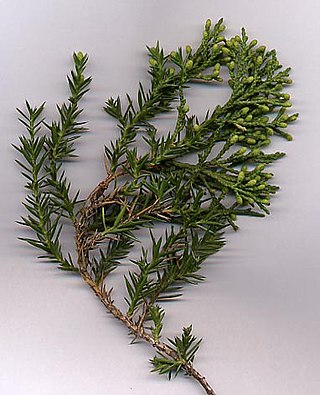
Juniperus chinensis, the Chinese juniper, is a species of plant in the cypress family Cupressaceae, native to China, Myanmar, Japan, Korea and the Russian Far East. Growing 1–20 metres tall, it is a very variable coniferous evergreen tree or shrub.

Rubus occidentalis is a species of Rubus native to eastern North America. Its common name black raspberry is shared with other closely related species. Other names occasionally used include bear's eye blackberry, black cap, black cap raspberry, and scotch cap.

Idiospermum is a monotypic genus in the family Calycanthaceae. The sole included species is Idiospermum australiense − commonly known as idiotfruit, ribbonwood, or dinosaur tree − which is found only in two small areas of the tropical rainforests of northeastern Queensland, Australia. It is a relic of the ancient forests of Gondwana, surviving in very localised refugia for 120 million years, and displaying features that are almost identical to fossil records from that time. As such it provides an important insight into the very early evolution of flowering plants.

Cornus kousa is a small deciduous tree 8–12 m (26–39 ft) tall, in the flowering plant family Cornaceae. Common names include kousa, kousa dogwood, Chinese dogwood, Korean dogwood, and Japanese dogwood. Synonyms are Benthamia kousa and Cynoxylon kousa. It is a plant native to East Asia including Korea, China and Japan. Widely cultivated as an ornamental, it is naturalized in New York State.

The University of Delaware Botanic Gardens are botanical gardens and an arboretum located on the campus of the University of Delaware, in Newark, Delaware, United States. The gardens are open to the public without charge.
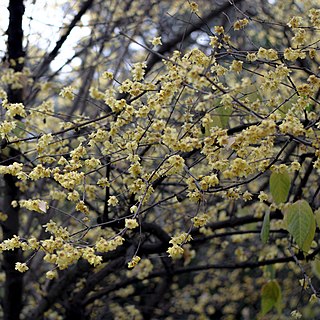
Chimonanthus is a genus of flowering plants in the family Calycanthaceae, native to China, but is also cultivated elsewhere in Asia, including Iran. The genus includes three to six species depending on taxonomic interpretation; six are accepted by the Flora of China. The name means winter flower in Greek.
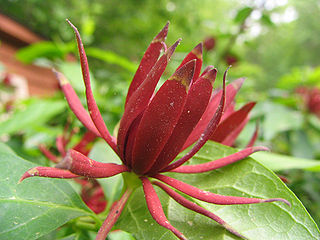
The Calycanthaceae are a small family of flowering plants in the order Laurales. The family contains three genera and only 10 known species, restricted to warm temperate and tropical regions:
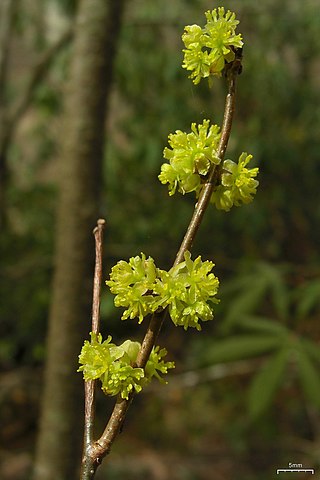
Lindera benzoin is a shrub in the laurel family. It is native to eastern North America, ranging from Maine and New York to Ontario in the north, and to Kansas, Texas, and northern Florida in the center and south. Within its native range it is a relatively common plant where it grows in the understory in moist, rich woods, especially those with exposed limestone.

Calycanthus floridus, or commonly known as the eastern sweetshrub, Carolina all spice, or spicebush, is a species of flowering shrub in the family Calycanthaceae. It is identifiable by its dark red flowers and fragrant scent. It is non-invasive and is found in the Southeastern United States region. The Nature Conservancy considers its conservation status to be G5, globally secure, indicating it is at low risk of extinction. It is presumed to have been extirpated from Ohio.

Rosa chinensis, known commonly as the China rose, Chinese rose, or Bengal rose, is a member of the genus Rosa native to Southwest China in Guizhou, Hubei, and Sichuan Provinces. The first publication of Rosa chinensis was in 1768 by Nikolaus Joseph von Jacquin in Observationum Botanicarum, 3, p. 7 & plate 55.
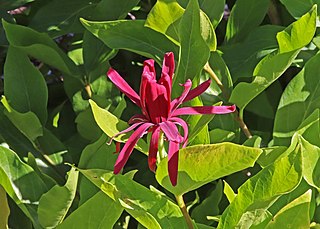
Calycanthus occidentalis, commonly called spice bush or western sweetshrub, is a species of flowering shrub in the family Calycanthaceae that is native to California and Washington state. It grows along streams and moist canyons in the foothills of mountains.

Chimonanthus praecox, also known as wintersweet and Japanese allspice, is a species of flowering plant in the genus Chimonanthus of the family Calycanthaceae, native to China. The plant is known as làméi in Chinese. The plant is also grown in Iran, where it is called gol-e yakh or "ice flower" in Persian.

Abelia chinensis, commonly known as Chinese abelia, is a species of flowering plant in the honeysuckle family Caprifoliaceae. It is a semi-evergreen, densely branched shrub with dark green foliage.

Calycanthus chinensis, known as Chinese sweetshrub, is a species of flowering plant in the family Calycanthaceae, native to Southeast China. It was first given a valid scientific name in 1964. It is cultivated as an ornamental flowering shrub, and has been hybridized with two other species in the genus Calycanthus to combine its larger and broader tepalled flowers with their scented and more colourful ones.


























